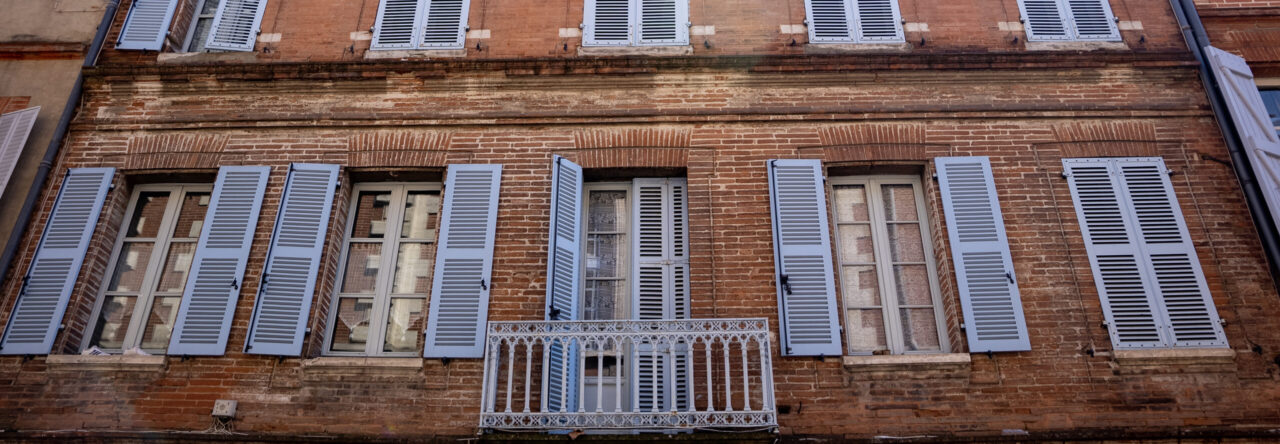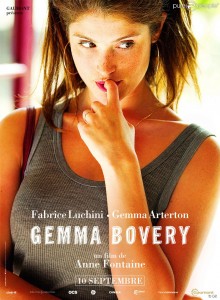During Fall break, the students and the Dickinson team packed their bags and left for Paris for four days, where luckily we were greeted by the sun and beautiful weather for our entire stay.
It was the first visit to the French capital for most of our students, and they discovered Paris through theater, important historical sites, art and of course, Parisian cuisine.
Wednesday evening we took a boat tour on the Seine to see some of the most important sites in the City of Light that line the Seine River. Luckily, it wasn’t too cold !
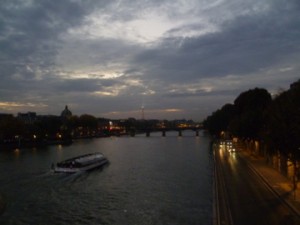
Schuyler : This is a photo of me in front of the base of the Eiffel Tower. I took this photo the first night of our stay in Paris, during a cruise on the Seine River. I chose this photo, because the Eiffel Tower is the symbol of Paris (and also because I lost my camera cord during the vacation and I don’t have a lot of other photos). I really liked Paris and all its sites and monuments- l’Hôtel de Ville, le Musée d’Orsay, la Saint-Chapelle, le Centre Pompidou, etc. Speaking of that, I like our visit to the Centre Pompidou a lot. Unfortunately, all my photos of the Centre are on my camera, but it was an amazing experience. I’ve never spent time in a big art museum without a lot of other people around. But our visit was completely private! We could listen to our guide and look at the works without bothering people or being bothered. However, it’s not just the fact that we were alone in the museum. I love art museums, but generally, I prefer impressionist and expressionist art. However, the works of the Centre Pompidou are very moving. It’s impossible to explain why, but I thought that the works really said something to the viewers. They make us think. I hope that I’ll have the chance to go back to the Centre Pompidou, but, unfortunately, my visit won’t be private.

Right after our bost tour, we went to the Comédie Française to see one of the most well-known works of Molière, Le Tartuffe (The Hypocrite) . That night, our students were very tired and went to bed early in order to be ready for the next day, which was even busier than our first day in Paris !
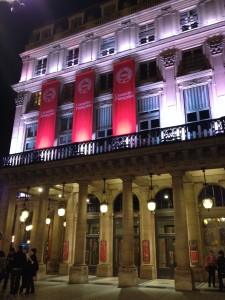
Thursday was dedicated to the history of Paris; in the morning we visited the Musée Carnavalet, a museum that contains countless works of art that illustrate the evolution of the city. Our visit to the Musée Carnavalet focused on the collection about Haussmanian Paris. In the afternoon, we visited the Hôtel de Ville (City Hall), which holds an important place in Paris’ history.
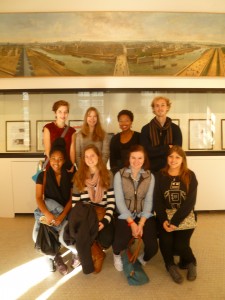
Le groupe au Musée Carnavalet


Le Musée Carnavalet
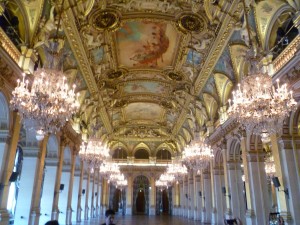
La Salle des Fêtes à l’Hôtel de Ville
We concluded our guided tours Friday morning at the Centre Pompidou, which is home to the National Museum of Modern Art. The Centre Pompidou is located in the heart of Paris, however in an emblematic building of the 20th century. At the Centre Pompidou we switched gears and instead of discussing the history of Paris, we learned about modern and contemporary art.
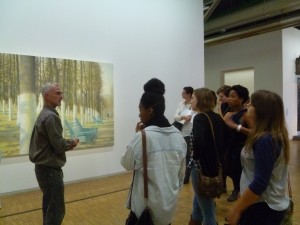
Keep reading to see how our students spent their free time in Paris :
Jessica : Even though Toulouse is considered a big city, it does not compare to Pairs, the biggest city in France. I live just outside a big city in California and my dad lives right in the center of London, but I was not ready for Paris. In my opinion, the heart of the city, famous for the Eiffel Tower, lives in the museums. There is not a lack of things to do and it’s easy to be overwhelmed by the enormity of the city. In order to better understand and appreciate the city, it’s better to not just visit the touristy sites. The Arc de Triomphe and the Eiffel Tower are impressive, but my favorite parts of the trip were the museums. Specifically, I enjoyed the Musée d’Orsay and the Rodin Museum. The Musée d’Orsay, located in what used to be an old Parisian train station, holds French art from Monet, Manet, Degas and Van Gogh, to name a few, that date back to 1848-1915. There is also a clock that gives a good view of the Seine and dates back to when the train station functioned. The Rodin Museum, another incredible museum, holds a large collection of sculptures and works by Rodin. For both museums, the buildings themselves are impressive and beautiful, let alone the art work.
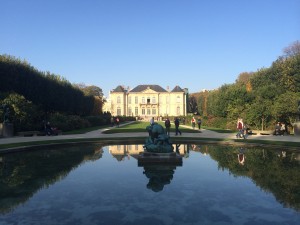
The gardens at the Musée de Rodin
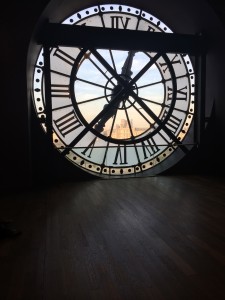
Clock at Musée d’Orsay

View of Paris from the clock at Musée d’Orsay
Shelby : During our free time I went to Montmartre and the Tuileries Gardens with friends. We also visited the Museum d’Orsay and the Rodin Museum. I really liked the Rodin Museum. It was more tranquil than the other sites and houses very important and significant works of Rodin. The trip went very well and was a nice way to spend the break.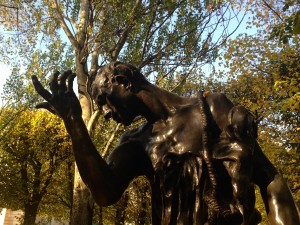
Grace : During our stay in Paris, I spent most of the visit with my friend, Tatiana. The excursion was her first visit to Paris, but my fourth. Because of that, we did some touristic things (the Museum d’Orsay, the Palace of Versailles, etc.), but we also did a few things that are less well-known, such as the Sainte-Chapelle church and we took a little break at Ladurée for the famous macaroons. Personally, I like areas that are less touristic- there are a lot fewer people and it’s usually much less hectic. Even so, we visited the Arc de Triomphe, and climbed the stairs to the top, too! By chance, we stumbled upon a military ceremony for All Saints’ Day, and it was really powerful. So in the end, a visit that would normally be too touristy for me, ended up being my favorite activity!
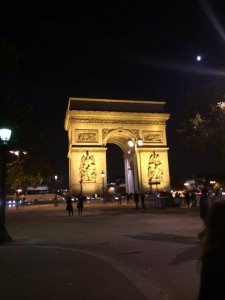
Tatiana : This last trip was by far my favorite: Paris, the City of Light. During our stay, I decided to visit the Versailles chateau. The train took about half an hour to get there, but when I saw the castle the first time, I knew why it was so popular; it’s huge, ornate, and covered in gold. The whole walk through the chateau and around the gardens, I kept thinking how could one family possibly need this much space? I learned that each of the children traditionally received their own apartments, which consisted of 5 rooms. I was surprised that these rooms, save for the last one, was open to the members of the court. I understand them wanting to get away from the nobility who would prod into their personal lives, but then it blew my mind again when I saw the three smaller living spaces located in the gardens. It seems excessive to me, but I’ll definitely be coming back!
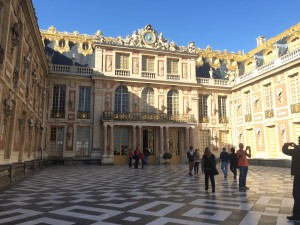
The Versailles Palace
Our last evening in Paris, the Dickinson group shared a meal at Café des Musées, where we tasted Parisian delicacies of the season.
Some last reflexions from our students about our trip :
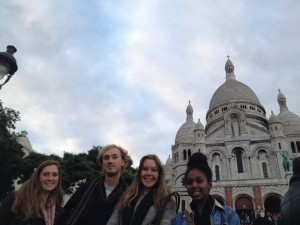 Greg : Our voyage to Paris with the Dickinson program was a very successful trip filled with art, good food and plenty of adventure. In only five days, I was able to see the Musée d’Orsay, the Pompidou Center, and the house and gardens of Rodin. Even after all the sights, I was able to catch the metro across the city and get a beer at Montmartre in the evening. Looking over the skyline of Paris at Montmartre is an incredible sight that brings tourists from all over the world to see. For me, Paris felt much more like a center of business with lots of fast moving traffic, the abundance of foreign languages and endless historical sites. Luckily, our trip to the city coincided with Halloween and I was more than happy to sport a bear costume I bought in Paris our first day. In all, our trip was yet another great cultural experience for our program and I can safely say that if I were to be so lucky, I would have no problem working in a city such as Paris in the future. As for now, Paris is hardly in the realm of any student budget and I can honestly say I could not be happier with the pace of life, studies and friends that I have here in Toulouse. For being twenty years old, I wouldn’t trade such a young and vibrant student city like Toulouse for anything!
Greg : Our voyage to Paris with the Dickinson program was a very successful trip filled with art, good food and plenty of adventure. In only five days, I was able to see the Musée d’Orsay, the Pompidou Center, and the house and gardens of Rodin. Even after all the sights, I was able to catch the metro across the city and get a beer at Montmartre in the evening. Looking over the skyline of Paris at Montmartre is an incredible sight that brings tourists from all over the world to see. For me, Paris felt much more like a center of business with lots of fast moving traffic, the abundance of foreign languages and endless historical sites. Luckily, our trip to the city coincided with Halloween and I was more than happy to sport a bear costume I bought in Paris our first day. In all, our trip was yet another great cultural experience for our program and I can safely say that if I were to be so lucky, I would have no problem working in a city such as Paris in the future. As for now, Paris is hardly in the realm of any student budget and I can honestly say I could not be happier with the pace of life, studies and friends that I have here in Toulouse. For being twenty years old, I wouldn’t trade such a young and vibrant student city like Toulouse for anything!
Kristen : Paris – the city of love that has been an indefinable source of inspiration and art for many countries, including the United States. The immense and decorative buildings, such as the Place de la Concorde, l’Hôtel de Ville, the Musée d’Orsay, etcetera, have an air of fantasy and reminisce for the days of the courtesans. However, juxtaposing this splendor are the tourist shops, who seem to sell the same things no matter where they are in Paris, and the crepes vendors whose menus are completely in English. This juxtaposition brings into light the current tension in France between their desire to maintain their culture and the desire to reap the financial benefits of tourism. This tension helps to explain why the stereotype that the French are snobby has persisted in the United States; it is hard for a country that has a lot of pride for its culture and its language to change itself to accommodate foreigners. Currently, since I am more aware of French culture, it is interesting to experience how an old city like Paris can keep its own culture while still enjoying the financial income from tourism. It is also fascinating to see how the French react when they learn that this American can speak French quite well!
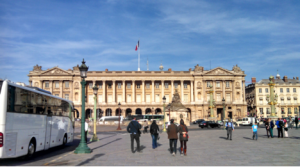
Needless to say, our students (and our chaperones, as well) returned to Toulouse very tired, but our fatigue reassured us that we had all made the most of our trip to Paris.
